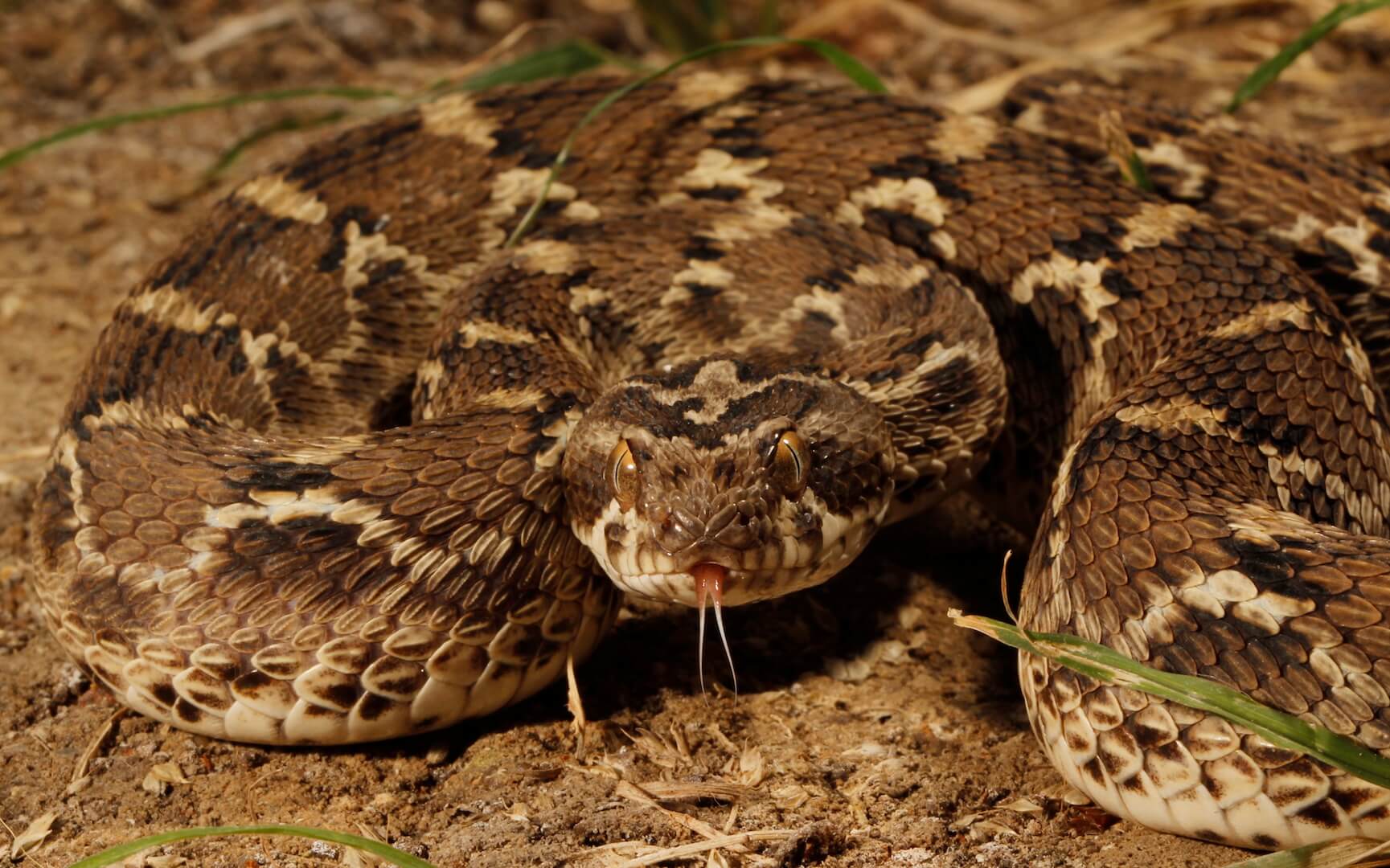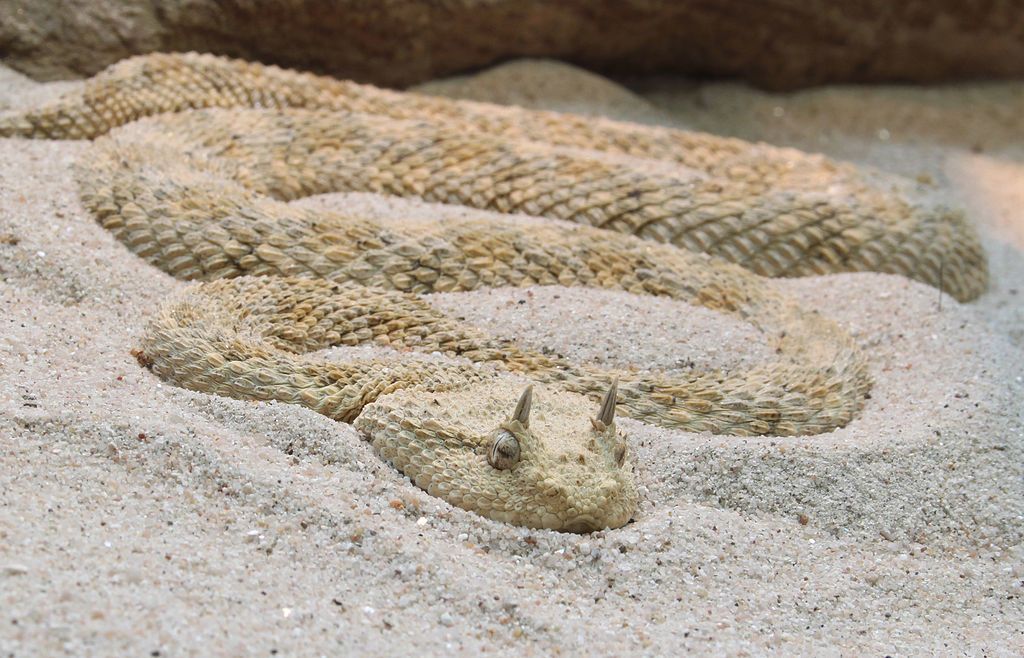A viper is a type of venomous snake known for its long, hinged fangs and potent bite. Vipers are found all over the world, especially in Europe, Asia, and Africa, and include well-known species like adders, pit vipers, and rattlesnakes (in the Americas).
What makes vipers stand out is their folding fangs, they can lie flat inside the mouth and swing forward when it’s time to bite. This allows vipers to deliver a quick, deep injection of venom, which helps them kill or paralyze their prey (usually small mammals, birds, or reptiles) and start digesting it even before swallowing.
Scientific Classification
-
Kingdom: Animalia
-
Phylum: Chordata
-
Class: Reptilia
-
Order: Squamata
-
Family: Viperidae
The Viperidae family includes many types of venomous snakes known for their hinged fangs and powerful venom. They are often confused with cobras or pythons, but vipers are a group of their own.
Common Names
-
Viper
-
Pit viper (for snakes with heat-sensing pits)
-
Adders (some European vipers)
-
In Yoruba: Ejò tó lè pọn
-
In Hausa: Maciji mai guba
-
In Igbo: Agwọ ngwọ (venomous snake)
Geographic Distribution
Vipers live in many parts of the world, including:
-
Africa
-
Europe
-
Asia
-
North and South America
They’re found in forests, deserts, grasslands, rocky areas, and even near farms.
Physical Characteristics
-
Body: Thick, muscular, and covered in keeled (ridged) scales
-
Head: Broad and triangular with narrow neck
-
Fangs: Long, hinged, and fold back when not in use
-
Pupils: Vertical slits (like a cat’s) for night vision
-
Size: Ranges from 30 cm to over 2 meters depending on species
Image showing a viper showing its triangle-shaped head and vertical pupils (Source: Dreamstime)
Major species of Vipers
1. Gaboon Viper (Bitis gabonica)
-
Found in Central and West Africa
-
One of the largest and heaviest vipers
-
Striking pattern for camouflage in leaves
-
Has the longest fangs of any snake (up to 5 cm)
-
Delivers massive doses of venom
 Image showing a Gaboon viper perfectly camouflaged (Source: iStock)
Image showing a Gaboon viper perfectly camouflaged (Source: iStock)
2. Puff Adder (Bitis arietans)
-
Widespread across sub-Saharan Africa
-
Thick-bodied, aggressive if threatened
-
Known for loud hissing (puffing) and sudden strikes
-
Responsible for many snakebite cases in Africa
Image Showing a Puff adder in defense position (Source: Dreamstime)
3. Saw-Scaled Viper (Echis carinatus)
-
Found in Africa, the Middle East, and South Asia
-
Small but extremely fast and venomous
-
Makes a rasping sound by rubbing scales together
-
Dangerous due to its speed and wide range
 Image showing a saw-scaled viper on sand, creating a warning sound (Source: Roundglass Sustain)
Image showing a saw-scaled viper on sand, creating a warning sound (Source: Roundglass Sustain)
4. Horned Viper (Cerastes cerastes)
-
Lives in deserts of North Africa and the Middle East
-
Has horn-like scales above its eyes
-
Sidewinder movement helps it glide across hot sand
-
Excellent desert camouflage
 Image showing a horned viper on a sandy dune (Source: Emory University)
Image showing a horned viper on a sandy dune (Source: Emory University)
5. Russell’s Viper (Daboia russelii)
-
Found in South Asia
-
Highly venomous, with a strong, dramatic hiss
-
One of the “Big Four” snakes responsible for snakebites in India
-
Patterned with dark circles down its back
 Image showing a russell’s viper raising it’s head for movement with alert eyes (Source: iStock)
Image showing a russell’s viper raising it’s head for movement with alert eyes (Source: iStock)
Fun facts about Vipers
-
Vipers can strike in less than a second
-
Their venom is used in medical research, especially in blood pressure treatments
-
Some species give live birth instead of laying eggs
-
Pit vipers (like rattlesnakes) can “see” warm prey using heat-sensing pits
Venom vs Bite: what happens?
Viper venom can:
-
Destroy tissue (cytotoxic)
-
Disrupt blood clotting
-
Cause pain, swelling, or death if untreated
Important: Immediate medical help is essential. Antivenom saves lives.
Importance to the Ecosystem
Vipers play a big role in keeping rodent populations under control. Without them:
-
Rats and mice could overrun crops
-
Disease-carrying pests would increase
-
The natural balance between predator and prey would break down
Threats to Vipers
Despite being feared, vipers face several dangers:
-
Habitat loss from farming and construction
-
Killing out of fear or superstition
-
Illegal pet trade and traditional medicine hunting
-
Climate change affecting breeding and hibernation cycles
Conservation Status
Some viper species are common, but others, like the Armenian viper or Ursini’s viper, are endangered due to shrinking habitats and hunting.
Conservation efforts include:
-
Public education to reduce fear and myths
-
Snakebite response training in rural areas
-
Habitat protection in reserves and parks
Viper vs Cobra
| Feature | Viper | Cobra |
|---|---|---|
| Head | Triangular | Narrow with hood |
| Venom Type | Cytotoxic (tissue damage) | Neurotoxic (nerve damage) |
| Fangs | Long and hinged | Short and fixed |
| Warning Display | Hiss or rattle | Hood flare and hiss |
| Bite Delivery | Quick, deep strike | Slower, but with long hold |
IF you find a snake in your area or need help with wildlife, you can reach out to us at Doctor Hulk Veterinary Hospital, or simply call us through 08143397614.














Reviews
There are no reviews yet.